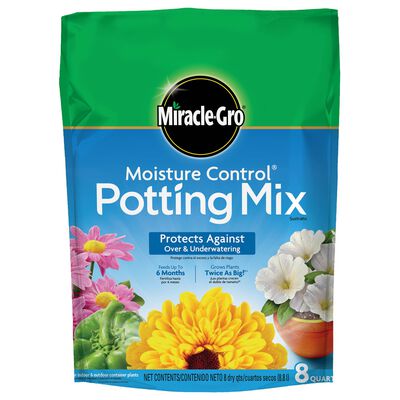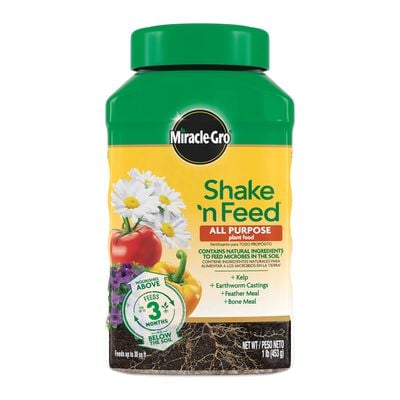
How to Grow a Natural Dye Garden for Every Space
Turn your plants into a rainbow of colors for one-of-a-kind creations.
If it seems like your Pinterest feed has become awash in images of natural dyes, you're not wrong—they're having a moment, and one that seems here to stay. (Yay!) Their rise in popularity is partially because growing your own botanical colors is easy. Plus, it gives you reason to use your garden in new ways while attracting craft-loving kids to the world of plants.
We know you're dye-ing (sorry, not sorry) to get out there and give it a whirl, so here's everything you need to successfully plant your own natural dye garden in a raised bed, a group of pots, or just one bursting-with-color container. Regardless of how big you go, about a month after planting, add Miracle-Gro® Shake 'n Feed® All Purpose Plant Food. Follow the label instructions to help your plants produce beautiful blooms and leaves, and grow strong enough to resist disease.
For Backyards: A Natural Dye Raised Bed Garden
Turn a 4x4 raised bed into a colorful garden filled with beautiful blooms and classic veggies.
What you'll need:
- 1 indigo (Indigofera tinctoria; use the leaves)
- 6 red and/or yellow onions (more if it's a smaller variety; use the skins)
- 9 beets (more if it's a smaller variety; use the roots)
- 1 tropical hibiscus (use the flowers)
- 1 lavender (use the flowers)
- 2 spinach (use the leaves)
- 8 marigolds (use the flowers)
- Miracle-Gro® Raised Bed Soil
What to do:
Plant indigo and hibiscus, the taller of these future dyes, toward the back of your raised bed so they don't block the sun. Lavender and spinach will be easy to harvest in the center, while beets and onions are better near the edges so you can easily pull them out of the soil. Line your bed with a row of marigolds so they can help attract pollinators and keep pests at bay.

For Decks & Patios: A Natural Dye Container Garden
Fill your deck with bold color and beautiful foliage with a group of containers. (For which part of the plant to use to create the dye, check out the plant list in the raised bed section above.)
What you'll need:
- 12-inch pot (at least a foot deep): 2 onions and 3 beets
- 18- to 24-inch pot: 1 hibiscus and 6 marigolds
- 14-inch pot: 2 spinach and 3 marigolds
- Miracle-Gro® Potting Mix
What to do:
We've taken the guesswork out of knowing which plants grow best together, but follow the planting instructions on the back of your seed packets or plant tags for top-notch results. Just remember, the soil in containers dries out more quickly than that in a raised bed, so water them frequently. If the top inch is dry, give them a drink! Get ready, you're going to have an amazing spectrum of colors to use, and with the plants just outside your door, you might have a hard time stopping.

For Balconies: A Natural Dye Single Container Garden
Even if you only have a small balcony, you can still grow plants perfect for dyeing. (To learn which part of the plant to use to create the dye, see the plant list in the raised bed section above.)
What you'll need:
- 14-inch pot: 2 spinach and 3 marigolds
- Miracle-Gro® Potting Mix
What to do:
In just one 14-inch pot you can grow what you need to make yellow and green hues. These colors have long been associated with nature, so using them for natural dyes seems only fitting. You'll lend the feeling of earthy serenity to everything you tint. Just keep your container well-watered; the soil in pots tends to dry out faster than that in a raised bed.
How to Make Botanical Colors
Creating and using plant dyes is more of an art than a science. Because every plant—and even different flowers from the same plant—contain different amounts of pigment (we're looking at you, hibiscus), it's important to keep an open mind about what your final product will look like. But the mystery is part of the excitement!
1. Mordant the Fiber
First things first: Synthetics, like polyester, won't pick up natural dyes, so opt for cotton or another plant fiber. Before you jump into making your dye, you need to pre-treat your material in a mordant to help the dye adhere to it. Here's how.
- Place your fabric in hot water with a squirt of dish soap for 10 minutes to remove any dirt or oil, then rinse.
- Fill a clean stock pot with 2 quarts of water.
- Add 1 tbsp. alum (find it in the spice aisle) and 1 tsp. baking soda.
- Add your fabric.
- Bring to a boil, then simmer on low for two hours.
- Let the material cool off while letting the fabric soak a few more hours.
2. Make the Dye
- Regardless of which plant(s) you're using, the process is essentially the same. If you're a multi-tasker, do this while your fabric soaks.
- Harvest your flowers and/or leaves.
- Roughly chop them and add to a stock pot on the stove.
- Add enough water to cover the plant material.
- Simmer over low heat (typically around an hour) until the plant material is wilted and faded, and the pigment has seeped into the water.
- Strain out the plant material and discard it in your compost or trash.
3. Dye the Fabric
And now, the moment you've been waiting for…dye that fabric!
- Place your cotton in the dye.
- Bring it to a boil for 5 minutes, then simmer for 2 hours.
- Turn off the heat, then let the fabric soak for a few hours or overnight.
- Take the material out and drain off excess dye.
- Rinse it thoroughly in cold water.
- Allow it to dry and admire your work!
There are countless ways to use your natural dyes, from cloth napkins to pillow cases to macramé planters. Once you get going, you and your family will soon be admiring your very own homegrown, hand-dyed creations. So dream big and in full color!


